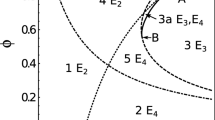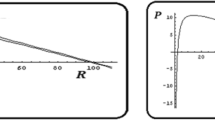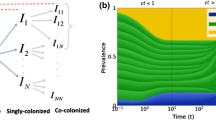Abstract
In this paper, we revisit a host–parasite system with multiple parasite strains and superinfection proposed by Nowak and May (Proc R Soc Lond B 255(1342):81–89, 1994), and study its global dynamics when we relax the two strict conditions assumed therein. As for system with two parasite strains, we derive that the basic reproduction number \(R_0\) is the threshold condition for parasite extinction and the invasion reproduction number \(R_i^j\ (i,j=1,2,i\ne j)\) is the subthreshold condition for coexistence of two parasite strains. As for system with three parasite strains, we are surprised to discover the global stability of parasite-free and coexistence equilibrium, which is distinct from the previous result. Furthermore, for system with n strains, we obtain the global asymptotical stability of the parasite-free equilibrium, conjecture a general result on the global stability of coexistence equilibrium and provide two numerical examples to testify our conjecture.






Similar content being viewed by others
References
Alizon S (2013) Co-infection and super-infection models in evolutionary. Interface Focus 3(6):20130,031
Antia R, Levin BR, May RM (1994) Within-host population dynamics and the evolution and maintenance of microparasite virulence. Am Nat 144(3):457–472
Boldin B, Diekmann O (2008) Superinfections can induce evolutionarily stable coexistence of pathogens. J Math Biol 56(5):635–672
Bremermann HJ, Thieme H (1989) A competitive exclusion principle for pathogen virulence. J Math Biol 27(2):179–190
Bull J (1994) Perspective: virulence. Evolution 48(5):1423–1437
Choisy M, de Roode JC (2010) Mixed infections and the evolution of virulence: effects of resource competition, parasite plasticity, and impaired host immunity. Am Nat 175(5):E105–E118
Denysiuk R, Silva CJ, Torres DFM (2017) Multiobjective optimization to a TB–HIV/AIDS coinfection optimal control problem. Comp Appl Math 3:1–17
Diekmann O, Heesterbeek J, Metz JA (1990) On the definition and the computation of the basic reproduction ratio \({R_0}\) in models for infectious diseases in heterogeneous populations. J Math Biol 28(4):365–382
van den Driessche P, Watmough J (2002) Reproduction numbers and sub-threshold endemic equilibria for compartmental models of disease transmission. Math Biosci 180(1):29–48
Frank SA (1992) A kin selection model for the evolution of virulence. Proc R Soc Lond B 250(1329):195–197
Futuyma DJ (2013) The evolution of evolutionary ecology. Isr J Ecol Evol 59(4):172–180
Hood M (2003) Dynamics of multiple infection and within-host competition by the anther-smut pathogen. Am Nat 162(1):122–133
Huijben S, Nelson WA, Wargo AR, Sim DG, Drew DR, Read AF (2010) Chemotherapy, within-host ecology and the fitness of drug-resistant malaria parasites. Evolution 64(10):2952–2968
Iannelli M, Martcheva M, Li X (2005) Strain replacement in an epidemic model with super-infection and perfect vaccination. Math Biosci 195(1):23–46
Li MY, Wang L (1998) A criterion for stability of matrices. J Math Anal Appl 225(1):249–264
Li MY, Graef JR, Wang L, Karsai J (1999) Global dynamics of a SEIR model with varying total population size. Math Biosci 160(2):191–213
Liu X, Chen X, Takeuchi Y (2011) Dynamics of an SIQS epidemic model with transport-related infection and exit-entry screenings. J Theor Biol 285(1):25–35
Martcheva M, Thieme HR (2003) Progression age enhanced backward bifurcation in an epidemic model with super-infection. J Math Biol 46(5):385–424
May RM, Anderson RM (1990) Parasite–host coevolution. Parasitology 100(S1):S89–S101
Mosquera J, Adler FR (1998) Evolution of virulence: a unified framework for coinfection and superinfection. J Theor Biol 195(3):293–313
Nowak MA, May RM (1994) Superinfection and the evolution of parasite virulence. Proc R Soc Lond B 255(1342):81–89
Pugliese A (2002) On the evolutionary coexistence of parasite strains. Math Biosci 177:355–375
Read AF, Taylor LH (2001) The ecology of genetically diverse infections. Science 292(5519):1099–1102
Stunzenas V (2001) Parasite–host interaction: a new point of view on immune regulation. Acta Zool Lituanica 11(4):405–416
Xu D, Sandland GJ, Minchella DJ, Feng Z (2012) Interactions among virulence, coinfection and drug resistance in a complex life-cycle parasite. J Theor Biol 304:197–210
Zhang P, Sandland GJ, Feng Z, Xu D, Minchella DJ (2007) Evolutionary implications for interactions between multiple strains of host and parasite. J Theor Biol 248(2):225–240
Acknowledgements
We are grateful to the editors and the anonymous referees for their careful reading and helpful comments which led to an improvement of our manuscript. L. Liu is supported by the National Natural Science Foundation of China (11601239) and Scientific and Technologial Innovation Programs of Higher Education Institutions in Shanxi (ISTP). X. Liu is supported by the National Natural Science Foundation of China (11671327). X. Ren is supported by the National Natural Science Foundation of China (11901477).
Author information
Authors and Affiliations
Corresponding author
Additional information
Publisher's Note
Springer Nature remains neutral with regard to jurisdictional claims in published maps and institutional affiliations.
Appendices
Appendix A: Equivalency of Inequality (7)
Proof
Firstly, we show that \(R_1^2>1\) implies that \(x^*>0\). Note that \(R_1^2>1\) can be rewritten as \(\left[\frac{R_1}{R_2}>1+\frac{su(R_2-1)}{u+v_1}\right]\), which yields that \(\left[R_1-R_2>\frac{su(R_2-1)}{u+v_1}\cdot \frac{\beta_2 k}{u(u+v_2)}\right]\). Thus, we have \(\left[\frac{u}{k}(u+v_1)(u+v_2)(R_1-R_2)+us{\beta_2}>su{\beta_2} R_2>0\right]\), which can guarantee that \(x^*>0\).
Next, we show the conclusion holds under the condition \(x^*>0\). We now show that \(x^*>{(u+v_1)}/{\beta _1}\) is equivalent to the inequality \(R_2^1>1\). It follows from \(x^*>{(u+v_1)}/{\beta _1}\) that we have
which can be rewritten as
That is,
Thus, one has
Therefore, we have
Similarly, \(x^*<{(u+v_2)}/{\beta _2}\) is equivalent to \(R_1^2>1\). \(\square \)
Appendix B: Proof of Theorem 2
Proof
The Jacobian matrix at \(E_0\) for the right hand side of system (2) is given by
It is easy to see that the eigenvalues of \(J(E_0)\) are \(\lambda _1=-u,\lambda _2=(u+v_1)(R_1-1),\lambda _3=(u+v_2)(R_2-1)\). Noting that \(R_0<1\), we can conclude that all eigenvalues of \(J(E_0)\) are negative. When \(R_0>1\), \(J(E_0)\) has at least one positive eigenvalue. Hence, the parasite-free equilibrium \(E_0\) is locally asymptotically stable if \(R_0<1\) and is unstable if \(R_0>1\). This completes the proof. \(\square \)
Appendix C: Proof of Theorem 3
Proof
The Jacobian matrix at \(\bar{E}_1\) for the right hand side of system (2) is given by
and its second additive compound matrix is
Then, one has
hold if \(R_2^1<1\). Thus, it follows from Lemma 2.1 that \(J(\bar{E}_1)\) is stable when \(R_2^1<1\). When \(R_2^1>1\), \(J(\bar{E}_1)\) has at least one positive eigenvalue. Thus, \(\bar{E}_1\) is locally asymptotically stable if \(R_2^1<1\) and it is unstable if \(R_2^1>1\). This finishes the proof of Theorem 3. \(\square \)
Appendix D: Proof of Existence of \({E}^*\)
Proof
By using (22), one has
if \(h_2>0\). Furthermore, we have
if \(h_1>0\). Substituting (23) and (24) into (20) yields the first relation of \(x^*\) and \(y^*\).
It follows from system (2) that we obtain
which is derived according to the subtracting between the second and third equations. Thus, we have the other relation of \(x^*\) and \(y^*\). Combining those two relations, we can solve the positive solution \(E^*\) of system (2) in this specific way.
Appendix E: Proof of Existence of \(\widetilde{E}^*\)
Proof
It follows from (22) that we have
if \(H_3>0\). Furthermore, we have
if \(H_2>0\) and
if \(H_1>0\). Substituting (26)–(28) into (20) yields the first relation of \(\widetilde{x}^*\) and \(\widetilde{y}^*\).
It is easy to derive that
Here, the second equation is derived from the subtracting between the fourth and third equations. Combining the above two equations, we can solve
if \(H_0>0\). Substituting (29) into the first relation of \(\widetilde{x}^*\) and \(\widetilde{y}^*\) yields that
where
Thus, there exists a unique positive \(\widetilde{y}^*\) if and only if \(A\ne 0\), \(AB>0\) and \(H_i>0, i=0,1,2,3,4\). \(\square \)
Rights and permissions
About this article
Cite this article
Liu, L., Ren, X. & Liu, X. A Host–Parasite System with Multiple Parasite Strains and Superinfection Revisited: The Global Dynamics. Acta Biotheor 68, 201–225 (2020). https://doi.org/10.1007/s10441-019-09359-7
Received:
Accepted:
Published:
Issue Date:
DOI: https://doi.org/10.1007/s10441-019-09359-7




